Guest contribution by Cormac Donnelly
I am, at heart, a techno-nostalgiast and I’ve worked with tape machines of one kind or other for most of my career. When I sold my 2” multi-track, in 2010, I resolved almost immediately to get myself another tape machine (albeit something a little smaller than the 250kg Otari I had just parted with). A few weeks later, I found myself owning two portable Nagras. I have since realised that the only reason any one person should own two Nagras is so they can indulge in a spot of worldizing.
Worldizing refers to a technique Walter Murch developed early in his career where he would take a piece of music, dialogue or FX, reproduce it in a real space using a portable tape machine and speaker, and then re-record it on another machine in an attempt to inform the original sound with some of the acoustic properties of the space. While Murch may not be able to lay claim to having invented the notion (when he worked on the 1998 restoration of ‘Touch of Evil,’ he discovered Orson Welles had had a very similar thought back in 1958) he was able to explore it’s creative possibilities in a much more complete fashion thanks to the development of the Nagra; a high quality, reliable, and (most importantly) portable tape recorder courtesy of the Swiss company Kudelski SA.
For my own worldizing experiment I took my cue from the interview with Murch on the 2004 DVD release of THX 1138; where he not only explains worldizing, but also goes on to make an interesting point about the effect that speed and pitch can have on a sound’s interaction with space it occurs in.
[youtube]http://www.youtube.com/watch?v=AL8yRZvhyZM[/youtube]
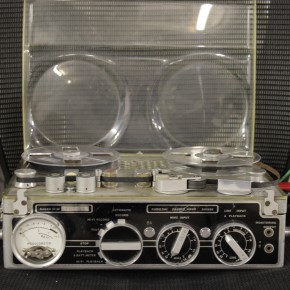 For playback I used a Nagra III (circa 1964) which, as far as I can tell, was used by Croatian Radio as a reporters machine before being sold on in the early 90’s. Like most of the earlier Nagras it’s a mono machine featuring one mic input. In preparation for the experiment I made a selection of FX and tracked them onto a reel of ¼“ AGFA 468 tape running at 7.5 IPS (inches per second). In the end I chose a Tommy Gun firing short bursts, an impact wrench, a lift mechanism and some sonar pings. An ADAM P22A powered monitor was fed by the line output and was found to produce the required oomph for the job at hand.
For playback I used a Nagra III (circa 1964) which, as far as I can tell, was used by Croatian Radio as a reporters machine before being sold on in the early 90’s. Like most of the earlier Nagras it’s a mono machine featuring one mic input. In preparation for the experiment I made a selection of FX and tracked them onto a reel of ¼“ AGFA 468 tape running at 7.5 IPS (inches per second). In the end I chose a Tommy Gun firing short bursts, an impact wrench, a lift mechanism and some sonar pings. An ADAM P22A powered monitor was fed by the line output and was found to produce the required oomph for the job at hand.
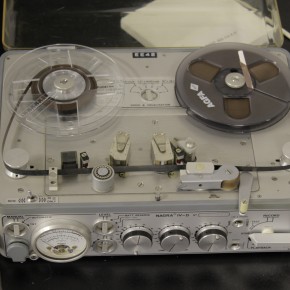 On the recording side of the equation I used a Nagra IV-D. Between 1969 and 1995 this particular machine was used by truck manufacturer ERF to record engines for analysis. It’s another mono machine, but it does have two mic inputs; though I opted to use only one in this case. Neither machine offers any form of power at the inputs (T-power and P48 could be added to the machines using optional adaptors) so I went for the best dynamic mic I could get my hands on, an Electro-Voice RE-20. The machine was loaded with an un-used reel of AGFA 468.
On the recording side of the equation I used a Nagra IV-D. Between 1969 and 1995 this particular machine was used by truck manufacturer ERF to record engines for analysis. It’s another mono machine, but it does have two mic inputs; though I opted to use only one in this case. Neither machine offers any form of power at the inputs (T-power and P48 could be added to the machines using optional adaptors) so I went for the best dynamic mic I could get my hands on, an Electro-Voice RE-20. The machine was loaded with an un-used reel of AGFA 468.
 The location for the recording was a large underground garage. After some playback experiments I fine-tuned the speaker and mic position; ending up with them approximately 30 feet apart with the mic off-axis to the speaker. I recorded the first pass with both machines running at 7.5 IPS.
The location for the recording was a large underground garage. After some playback experiments I fine-tuned the speaker and mic position; ending up with them approximately 30 feet apart with the mic off-axis to the speaker. I recorded the first pass with both machines running at 7.5 IPS.
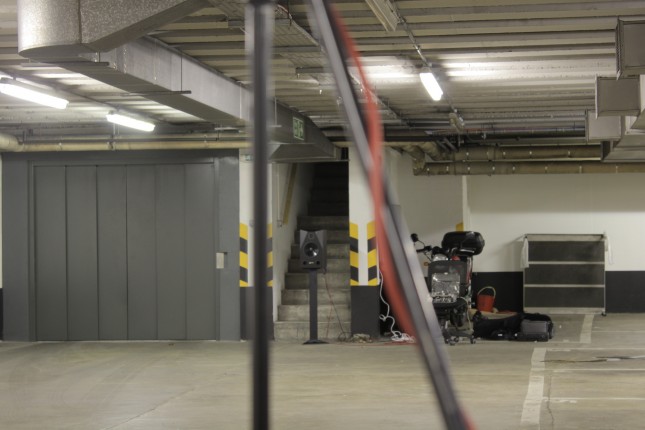 For the second pass I wanted to investigate Murch’s discovery concerning pitch and our perception of space. He noted that when he worldized a sound at four times it’s original speed the new recording, when played back at the original speed, made the space sound far larger than it actually was. I switched both the playback and record machines to 15 IPS (twice that of the original recording speed) to see if I could in some way replicate this effect.
For the second pass I wanted to investigate Murch’s discovery concerning pitch and our perception of space. He noted that when he worldized a sound at four times it’s original speed the new recording, when played back at the original speed, made the space sound far larger than it actually was. I switched both the playback and record machines to 15 IPS (twice that of the original recording speed) to see if I could in some way replicate this effect.
Lastly I wanted to see what would happen if I slowed down the speed for playback and record. So, I dropped both machines to 3.75 IPS and recorded a final pass. For these three recordings I only made small adjustments to the speaker volume and mic level to prevent clipping, I didn’t change the position of anything within the space.
Below are some of the results of my worldization session. Both MP3’s feature four repetitions as follows; first is the dry FX, next a wet/dry mix of the 7.5 IPS pass, third a wet/dry mix of the 15 IPS pass and lastly a wet/dry mix of the 3.75 IPS pass. (The annoying whine in the background is a server which I’d completely forgotten was in the garage. I initially planned to try and remove it from the recordings, but on listening back I liked hearing how it changed with the recording speed…and I didn’t really want to mess about with the integrity of the worldized recordings anyway.)
[soundcloud]http://soundcloud.com/cormacrestrike/worldized-tommy-gun-mix[/soundcloud]
[soundcloud]http://soundcloud.com/cormacrestrike/worldized-sonar-mix[/soundcloud]
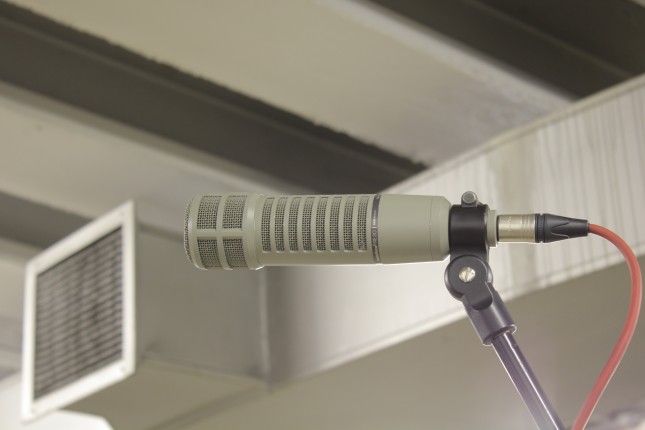 First of all, I can confirm that the straight pass at 7.5 IPS does a fine job representing the garage space. The decay on the Tommy Gun blasts even seems to capture something of the large metal air ducts which run around the ceiling of the room. My personal favourites though are the 15 IPS recordings, double the original speed of the FX. The space sounds enormous and there is a clear emphasis and enhancement of the low frequencies in the recording. The sonar pings also seem to pick up a harsh, upper mid spike from the worldization which I find quite appealing. In contrast the 3.75 IPS low-speed pass seems to have sucked all the ambience out of the space, and in doing so also emphasises the server whine.
First of all, I can confirm that the straight pass at 7.5 IPS does a fine job representing the garage space. The decay on the Tommy Gun blasts even seems to capture something of the large metal air ducts which run around the ceiling of the room. My personal favourites though are the 15 IPS recordings, double the original speed of the FX. The space sounds enormous and there is a clear emphasis and enhancement of the low frequencies in the recording. The sonar pings also seem to pick up a harsh, upper mid spike from the worldization which I find quite appealing. In contrast the 3.75 IPS low-speed pass seems to have sucked all the ambience out of the space, and in doing so also emphasises the server whine.
In an interview with Mix Magazine in April 1998 Walter Murch admitted that he didn’t go in for worldization much anymore.
“The digital technology is such that it’s now better, certainly easier, than I can do manually.”
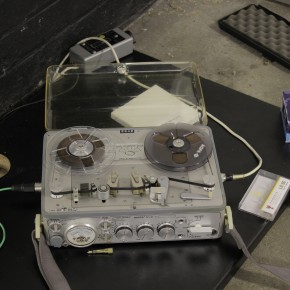 Having had a crack at it I can see his point. It’s quite a labour intensive process for what could be considered small return. But the return is something quite unique, something I think you’d be hard pressed to find in a plug in, and perhaps just the something you’re looking for; though for the sake of your sanity I’d recommend not doing it with two Nagras. At over 40 years old they no longer have any concept of sync.
Having had a crack at it I can see his point. It’s quite a labour intensive process for what could be considered small return. But the return is something quite unique, something I think you’d be hard pressed to find in a plug in, and perhaps just the something you’re looking for; though for the sake of your sanity I’d recommend not doing it with two Nagras. At over 40 years old they no longer have any concept of sync.
Feel free to download the WAV files from my session here.
Cormac Donnelly is an audio engineer and lecturer at Futureworks Media College in Manchester, UK. Please use the comments section below to thank him for sharing this experiment. Do you know what’s coming next in this little section? You’ve probably seen it down here a couple times in the past month or two. ;) Anyone who wishes to share something with the community is welcome and encouraged to do so. If you have an idea for an article you’d like to share, contact shaun.at.designingsound.org
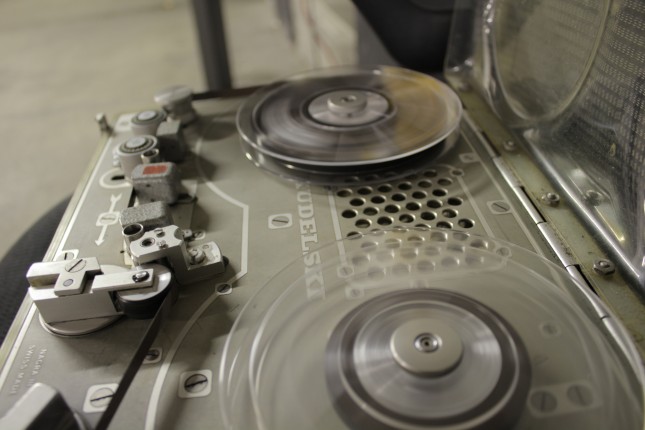
why not using a condenser mic?
Could this same effect be achieved with digital recording devices with the sound being played back in a space from a computer time compressed / pitched up?
@monbaza
Sounds like it’s because the analog recorder didn’t offer phantom power without some extra work/hardware.
That is just genius, how did I not think about it before??? I’ve done this in the box (resampling a sound with reverb and then timestretching/pitchshifting the result), and it’s quite interesting, specially for percussive sounds. I’ll definitely try it in the real world!
@Monbaza I think from the model IV onwards there were quite a few options on the Nagras including T and phantom power modules for the pres, not on mine though.
@Moses TCE and pitch-shifting does work.Not quite as much hassle as messing about with tape but still fairly complicated. Good fun though
Thanks for your response Cormac! I know what I am doing for the New Year.
Nice one Cormac!!
Worldizing done all analogue.. It makes me smile how creative engineers were when sourcing sounds in the analogue domain. No downloading of sound libraries needed for them! Great article, keep them coming!
I love worldizing the old-fashioned way. Works so well. I did the vari-speed verb trick in a game back in 2007 using a bathroom as a cave. Fun stuff. Great Article!
Nicely done. I like the idea of making your own sounds like this over using existing sounds on the web and tweak them.